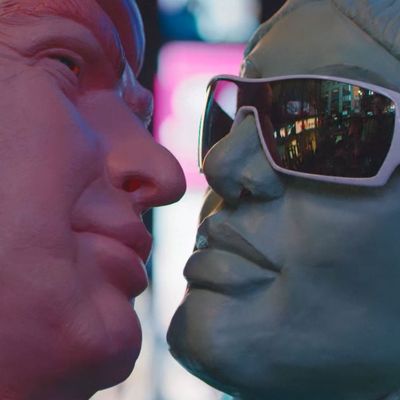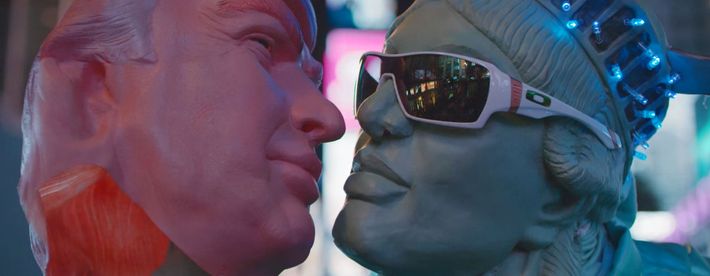

Khalif and Aaquil Brown are a pair of brothers raised in Mississippi who, under their monikers of Swae Lee and Slim Jxmmi, comprise Rae Sremmurd, the most successful rap duo of the past two years. Powered by their own contagious, hyperactive energy as well as by their association with Atlanta super-producer Mike Will Made It, the duo’s 2015 debut album SremmLife housed a series of sonically huge and tremendously popular club hits. “No Flex Zone” and “No Type” are just the most prominent SremmLife singles — the total number of platinum-charting tracks on the 11-track album is an astounding five. It’s hardly a surprise that SremmLife 2, their sophomore album due out next week, on August 12, is being eagerly anticipated. To prepare for its listening party, held on Tuesday at a sumptuous club in Soho, I revisited the original SremmLife on YouTube. Five of the tracks were audio-only and the five singles had videos to accompany them. The remaining track, “Up Like Trump,” is not a single. But it does have a music video which, as one might suspect, currently has a fair claim to being the creepiest, most revelatory music video on Earth.
This wasn’t always the case. Half of art is in the viewer’s perspective; views of art change with the times and the audience. When the instrumentals and lyrics for “Up Like Trump” were paired and when its video was choreographed and shot (the video was released on December 16, 2014, three weeks prior to the SremmLife launch), the song was just a banger, yet another fruitful product of the union between Mike Will’s digital trap vibes and the Brown brothers’ antic chants. In August 2016 it’s something else entirely. Then and now, close to all of the video’s material is fairly standard for a party song: It’s an extended montage of expensive settings and accessories, young women, more white than not and uniformly pleasing to behold, and brash posturing on the part of the musicians. There are broad aerial shots of a city at night (it’s New York City). There are closer shots from within what looks to be a lavish penthouse with a fine view of the city where a party has convened. There are product placements: Beats pills, Hummers, Premís Legend cognac. There are joyrides: on the top floor of a tour bus, hanging out from Hummer windows as the Hummers churn over a bridge. There are a few idiosyncratic elements, of course, such as nunchucks, a person in a Statue of Liberty costume, and a person in a Batman costume, but none seem truly out of place: the nunchucks feature in the lyrics and Lady Liberty fits the already-established “New York” and “attractive women” themes well enough. The abrupt, one-time appearance of Batman, though obviously very New York, is somewhat ominous.
As far as omens go, though, nothing else in the video comes close to matching the recurrent appearances of people wearing rubber Donald Trump masks. There are people in Trump masks dancing in the penthouse and people in Trump masks enjoying themselves on the tour bus. There’s a Trump mask showing out with the Brothers Sremm as they stunt, lit by the headlights of parked Hummers. There’s an image of the Statue of Liberty gazing lovingly at an empty mask of Trump. For a long second the emblem of New York’s (and America’s) appeal to immigrants looks onto the figure of the New Yorker who, between the releases of SremmLife and SremmLife 2, has successfully rebranded himself as the avatar of hatred and paranoia regarding immigrants: They face each other at a range reserved for intimate relations and reflections in mirrors.
These are surreal and shocking images, but their surrealism and shock aren’t based in any radical, fish-and-bicycle incompatibility between Trump and the iconography of hip-hop music videos, or between Trump and Lady Liberty, so much as in the way they call forth a complicity that, though overlooked, has always been plain to see. As others have noted, Rae Sremmurd is far from the only rap act to mention Donald Trump in its lyrics. Trump has always been cited. His original rise to fame and infamy, occurring in New York during the ‘80s, coincided exactly with hip-hop’s own swift ascension into notoriety on the national stage. Like a rapper, Trump was indifferent to the opinions of others: He said what he wanted to say. Like more and more rappers, Trump seemed to be getting ever richer — moreover, he was getting richer, like many rappers, by announcing how rich he already was. So it wasn’t a surprise that Trump’s name became a metonym for money, in much the same way that rap itself became associated with financial prosperity. (Even a rapper as humble and relatively unconcerned with wealth as Phife Dawg was not averse to utilizing Trump in a verse: “Beeper’s going off like Don Trump gets checks.”)
With his blunt persona and unsavory associations, “Trump” was shorthand not just for money, but for money gaudily displayed, money irrespective of taste or social convention. Trump and rappers filled the same space in the national mythos once occupied by Jay Gatsby; but whereas Fitzgerald’s protagonist, sharing the same mob ties and lavish exhibitionism as Trump, was imbued with his author’s soft-hearted romanticism, Trump, self-authored, put forward unmitigated callousness tinged with racial paranoia. If Trump was a latter-day Gatsby, he was one for whom any trace of gentleness had been overwritten by the lack of care and pity typical of Tom (or Pat) Buchanan. But in either case, it’s clear that Trump and Gatsby represent money — money in such excess that polite society had to change to accommodate it, instead of the other way around.
And this, too, is what the mainstream of rap for the past two decades has represented, what’s made rap quintessentially American. (Though no less conformist than other nations of the globe, we aspire to become, and swiftly valorize, someone who tramples over social decencies in the successful pursuit of indecent wealth.) Hip-hop has launched itself into the forefront of American culture, and it could never have done so had it not entered into marriage with money on an obscene scale; furthermore, that marriage was far easier to consummate through music videos, which double as display cases for conspicuous consumption more effectively than music, blind and immaterial, ever could. Trump gets mentioned in rap lyrics, but the modern rap-music video is where his presence seems most pervasive: One could be forgiven for thinking that the medium as a whole had donned a Trump mask. So Trump’s appearance alongside Rae Sremmurd in their music video revealed more than it surprised: It was a manifestation of the devilish bargain rap entered into when, by worshipping money and its display over all else, it achieved domination over the nation’s popular culture. Trump has been hidden behind many lyrics and inside most videos, and the “Up Like Trump” video, in true Trump fashion, simply makes what was formerly concealed blatantly clear.
Meanwhile, Trump himself has been making some other things blatantly clear. Yet the naked virulence of white racism is a surprise only to those innocents for whom every instance of moral depravity is the first; more interesting is how Trump’s newly unwelcome presence in rap signals the implosion of the ideal buried underneath all that rap materialism. Strange as it now seems, Trump used to serve as a kind of intermediary between black rappers and white audiences: Possessed of the temperament of the former, the skin color of the latter, and the greed of both, he represented the neoliberal dream of a humanity united in its love of fame and wealth, of a society where the contents of one’s bank account mattered more than the color of one’s skin. But now, led by YG, the list of former friends and admirers of Trump who have renounced him grows longer by the day: Along with T.I., former friends such as Russell Simmons, and former celebrants such as Mac Miller, the Bernie bros of Rae Sremmurd have openly rejected him, refusing to play “Up Like Trump” at concerts. The reason for their disgust with Trump is self-evident. Just as there was once a Donald Trump latent in every rap lyric that vaunted the power of vast sums of new money to transcend racial divisions, there’s now a Donald Trump latent in every throb of resentment against nonwhites and “political correctness” (which is to say resentment of even the flimsiest, most cosmetic abridgment of white social power imaginable).
As he renders himself completely repulsive to hip-hop artists and their predominantly youthful fan base, Trump is accelerating the genre’s turn away from the apolitical, money-over-everything mentality that’s been hip-hop’s default setting since the late 1990s. Money remains as vital as ever, but in an age of rampant Trump-empowered racism it no longer seems sufficient on its own, and perhaps never was. This isn’t to argue that hip-hop artists should (or could) have kept the genre’s hands clean, or to suggest that many of them didn’t know what they were getting into. It’s not to claim that even at its most venal hip-hop culture lacked the power to alter social attitudes or economic standings, if only on a personal level. It’s just to say that it’s hard to envision a future for hip-hop where, more and more, the message of the music comes ahead of money instead of being fused with it — a future where rising up in the world means opposing Trump, instead of coming with him.

